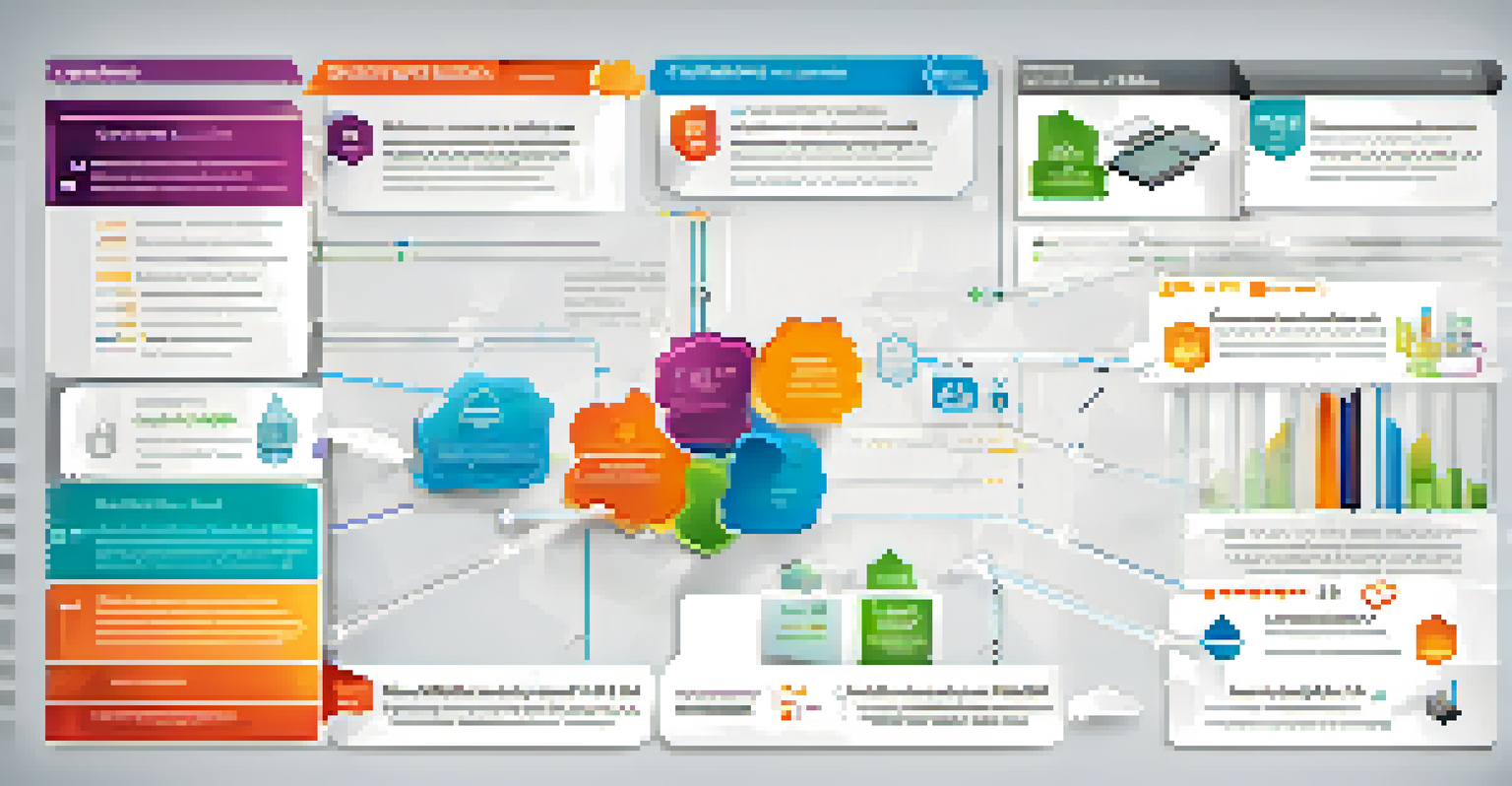RPA and Cloud Computing: A Perfect Match

Understanding RPA: What It Brings to the Table
Robotic Process Automation (RPA) is a technology that uses software robots to automate repetitive tasks. Imagine having a virtual assistant that can handle data entry, processing transactions, or even responding to emails, freeing up your employees for more strategic work. This not only boosts productivity but also minimizes errors, as robots follow predefined rules without fatigue. RPA is all about efficiency, making it a sought-after solution in various industries.
Automation is no longer a choice, but a necessity for businesses to remain competitive in today's fast-paced environment.
One of the key benefits of RPA is its ability to integrate with existing systems without the need for major changes. This means businesses can quickly implement it and start seeing results without lengthy IT overhauls. It's like adding an extra layer of workforce that works round the clock, ensuring that mundane tasks are handled seamlessly. Furthermore, RPA is scalable, so as your business grows, your automation can grow with it.
However, RPA is not just about speed; it's also about accuracy. For instance, in finance, automating invoice processing can drastically reduce human error, leading to faster approvals and payments. This accuracy translates to better customer relationships and improved service delivery. In essence, RPA is transforming the way organizations operate by streamlining operations and enhancing overall efficiency.
Introducing Cloud Computing: The Backbone of Modern Tech
Cloud computing is like having a virtual storage room and IT infrastructure that you can access from anywhere. Instead of maintaining physical servers, businesses can store and manage data in the cloud, leading to significant cost savings and flexibility. This on-demand access to resources means that companies can scale their operations without the burden of hefty upfront investments. It's a game-changer in how organizations approach technology.

The beauty of cloud computing lies in its ability to provide real-time data access and collaboration. Teams can work together from different locations, sharing information instantaneously, which is crucial in today's fast-paced environment. Think of it as a digital workspace where everyone has the tools they need to collaborate effectively, no matter where they are. This not only boosts teamwork but also speeds up decision-making processes.
RPA Boosts Efficiency and Accuracy
Robotic Process Automation (RPA) significantly enhances productivity by automating repetitive tasks while minimizing human errors.
Moreover, cloud computing enhances security and data backup solutions. With the rise of cyber threats, having your data stored in secure cloud environments can provide peace of mind. Companies can leverage advanced security features that protect their sensitive information, ensuring compliance and reducing risks. In short, cloud computing is the robust foundation that supports modern business operations.
The Synergy Between RPA and Cloud Computing
When RPA and cloud computing come together, they create a powerful synergy that transforms business processes. By deploying RPA in the cloud, organizations can access the advantages of both technologies, resulting in enhanced efficiency and lower operational costs. It's like putting your automation on steroids, allowing it to perform at its best without the constraints of physical infrastructure. This combination enables businesses to automate tasks without worrying about the limitations of their existing systems.
Cloud computing is a revolution in the way we access and share information, making it an essential tool for modern businesses.
For instance, companies can run RPA bots in the cloud to handle high-volume tasks, such as data extraction and reporting. This means that as demand fluctuates, they can easily scale their automation efforts up or down based on their needs. Imagine a retail business that can automate inventory updates during peak sales periods without the need for additional hardware. It streamlines operations and optimizes resource allocation.
Furthermore, the cloud offers a centralized platform for managing RPA deployments, making it easier for organizations to monitor and analyze performance. This visibility allows for continuous improvement, as businesses can adjust their strategies based on real-time data. The combination of RPA and cloud computing leads to smarter, more agile operations that can adapt to ever-changing market demands.
Improved Scalability and Flexibility with Cloud-RPA Integration
One of the standout advantages of integrating RPA with cloud computing is the scalability it provides. Businesses can quickly ramp up their automation efforts without the need for significant investments in physical infrastructure. This flexibility is especially crucial for organizations experiencing rapid growth or seasonal fluctuations. It's akin to having an elastic band that expands and contracts based on your needs, ensuring you're always equipped to handle demand.
Moreover, with cloud-based RPA solutions, businesses can deploy bots in different regions or markets instantly. This global reach allows companies to maintain a consistent level of service across various locations, which is essential in today's interconnected world. For example, a multinational corporation can automate customer support in multiple languages simultaneously, enhancing customer satisfaction and streamlining operations.
Cloud Computing Enables Flexibility
Cloud computing allows businesses to scale operations and collaborate in real-time, transforming how teams work together across various locations.
This scalability also means organizations can experiment with new automation processes without the fear of overcommitting resources. They can test and iterate on different strategies, finding the best solutions that fit their needs. Ultimately, the combination of RPA and cloud computing empowers businesses to be more responsive, agile, and competitive in their respective industries.
Cost Efficiency: Reducing Operational Expenses with RPA and Cloud
Cost efficiency is a major driving factor for businesses to adopt RPA and cloud computing. By automating repetitive tasks with RPA, organizations can significantly reduce the need for manual labor, leading to lower operational costs. This is particularly beneficial for small to medium-sized enterprises that may have limited budgets but still want to enhance productivity and efficiency. Think of it as trimming the fat while keeping the muscle; you get the same results at a fraction of the cost.
Cloud computing complements this cost-effectiveness by eliminating the need for expensive hardware and maintenance. Instead of investing in physical servers, companies can pay for cloud services based on their actual usage. This pay-as-you-go model allows businesses to allocate funds more efficiently, ensuring they only pay for what they need. As a result, organizations can redirect those savings into other critical areas, such as innovation or customer service.
Additionally, the combination of RPA and cloud solutions can lead to quicker returns on investment. With faster implementation times and immediate access to the latest technology, businesses can start seeing the benefits of automation almost instantly. This financial agility enables organizations to stay competitive and responsive to market changes, ultimately driving long-term success.
Enhanced Compliance and Security through Cloud-Based RPA
In today's digital landscape, compliance and security are more important than ever. RPA combined with cloud computing helps organizations maintain strict compliance with regulations and standards. By automating data handling processes, companies can ensure that sensitive information is managed consistently and according to legal requirements. Think of it as having a safety net that catches any potential compliance issues before they escalate.
Cloud-based RPA solutions often come with built-in security features that enhance data protection. This means businesses can leverage advanced technologies, such as encryption and access controls, to safeguard their information. For instance, financial institutions can automate compliance checks while ensuring that customer data remains secure and confidential. This dual approach not only protects the organization but also builds trust with customers.
Cost Savings with Combined Solutions
Integrating RPA with cloud computing reduces operational expenses and provides a pay-as-you-go model, enhancing financial agility for organizations.
Furthermore, centralized monitoring in the cloud allows for better oversight of automated processes. Organizations can quickly identify and address any discrepancies, ensuring that they remain compliant with industry regulations. This proactive approach not only mitigates risks but also fosters a culture of accountability within the organization, leading to overall better governance.
Real-World Success Stories: RPA and Cloud in Action
Many organizations have successfully harnessed the power of RPA and cloud computing, leading to remarkable transformations. For example, a leading healthcare provider implemented cloud-based RPA to automate patient data entry and appointment scheduling. As a result, they were able to reduce administrative overhead and improve patient care, showcasing how automation can drive efficiency in critical sectors. It's inspiring to see how technology can make a tangible difference in people's lives.
Another example can be found in the finance sector, where a major bank utilized RPA and cloud solutions to streamline their loan processing. By automating data verification and compliance checks in the cloud, they significantly reduced processing times and improved customer satisfaction. This success story highlights the transformative potential of integrating RPA with cloud computing, making complex processes simple and efficient.

These real-world examples serve as a testament to the effectiveness of combining RPA and cloud technology. As more organizations recognize the benefits of this partnership, we can expect to see even more innovative applications emerging across various industries. The future is bright for businesses willing to embrace these technologies and harness their full potential.